The Department for Education estimates £700 million is spent on training new teachers each year – but for the past four years it has failed to hit the target number of trainees.
So what does the NAO think is going wrong?
1.The NAO says the main reason why more more teachers are needed is because existing ones leave the profession.
Schools rely on a constant supply of newly-qualified teachers to replace those leaving the workforce. But that pressure is getting bigger – the number of teachers leaving the profession rose by 11 per cent between 2011 and 2014.
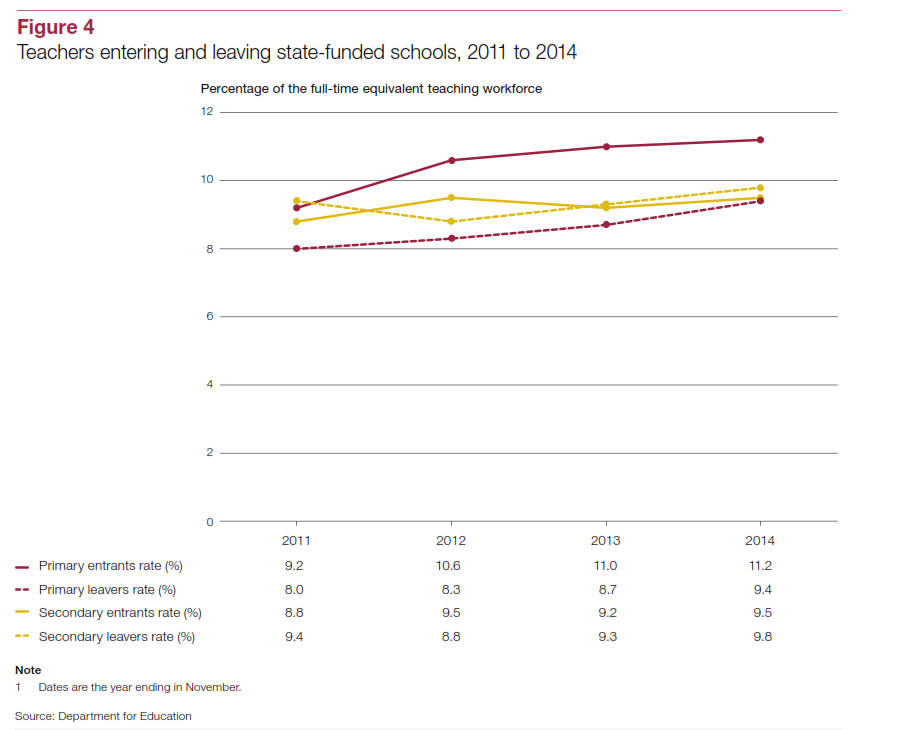
2. Reported vacancy rates in the profession have rocketed – although the NAO says the overall number is still “low”
They increased from 350 (0.1 per cent of the workforce) in 2011 to 3,210 (0.9 per cent) in 2014.
Vacancy rates are higher for computer science (1.5 per cent) and maths and science (1.4 per cent).
However the data is collected in November, when vacancy rates are comparatively low anyway, so the DfE accepts this doesn’t show the full picture.
3. Teachers without a degree in their subject is rising. (It’s more than 40 per cent in Spanish)
The proportion of of lessons in secondary schools taught by teachers without relevant post-A-level qualifications has grown.
This was most prevalent in computer science (44 per cent), Spanish (43 per cent), religious education (30 per cent) and physics (28 per cent).
In English and maths – one fifth of lessons are taught by teachers without further qualifications.
4. It is extremely hard to predict the right number of teachers needed each year, and the DfE isn’t doing a great job to ensure it gets things right
The NAO found that, while the DfE uses the best data available, the risk that it comes up with the incorrect number of needed trainee teachers remains “significant”.
That’s because:
– Many decisions are matters of judgement
– The DfE’s model is based on “inherently uncertain circumstances”
– There are gaps in the data
– The DfE has yet to independently verify its model’s accuracy.
5. The DfE is not doing a good job at meeting its own recruitment targets
Teacher training places are filled when the yellow bar is higher than the red bar. As you can see, that red bar has been creeping upwards the last few years.
6. The number of teacher trainees varies massively by region – and the DfE has a weak understanding of them
This year, 547 trainees were recruited for every 100,000 pupils in the North West, compared to just 294 in the East of England. The NAO says the DfE needs to do more to understand the important local and regional issues – and not just rely on schools to resolve it.
7. The DfE has handed out £620 million on bursaries to attract people to teaching in five years – without knowing whether it aids recruitment
The NAO said the DfE’s analysis of the longer-term impact has been “insufficient” given the level of investment.
The DfE has said it will now investigate the impact of its new £30,000 grants.
8. University trainees lag behind their peers in getting a teaching job within six months of qualifying
9. The drive in school-led training has not put off university providers
Many more schools now train teachers compared to five years ago. But only five of 75 higher-education institutions stopped offering training in the same time period.
10. The number of routes into teaching has been described as confusing and could put off potential applicants
The NAO found there is not “enough good information” available for potential applicants to make informed choices about where to train.
They also found the number of providers available depends where they live.
11. It costs the Department for Education more than four times as much to train a teacher via Teach First as opposed to School Direct…
But it is worth noting that there are no loans or grants for Teach First participants, and these are a cost to the government also. So a comparison cost of £16,000 vs £25,000 is a more reasonable comparison.
12 … And the NAO said a “significant” amount of Teach Firsters leave the profession after two years.
This graphic is important as it is the first time we have seen longitudinal numbers for all Teach First cohorts.
13. The DfE’s constant changes to its recruitment model is really annoying providers.
The NAO says it means providers do not have a clear and stable basis to plan for the long term.
14. So, is the DfE offering value for money?
It’s a big “no” from the NAO.
15. What happens now?
The NAO has drawn up four recommendations for the DfE.
1. It needs to demonstrate how it is improving recruitment and retention of teachers, and also at what cost. This includes examining the cost-benefits of different training routes and investigate whether bursaries are working.
2. The DfE should work with school leaders to develop a better understanding of local demand and assess whether its models are accurate
3. Prospective applicants need clearer and more accessible information – akin to a “good university guide”
4. Providers need greater certainty to help them plan long term.



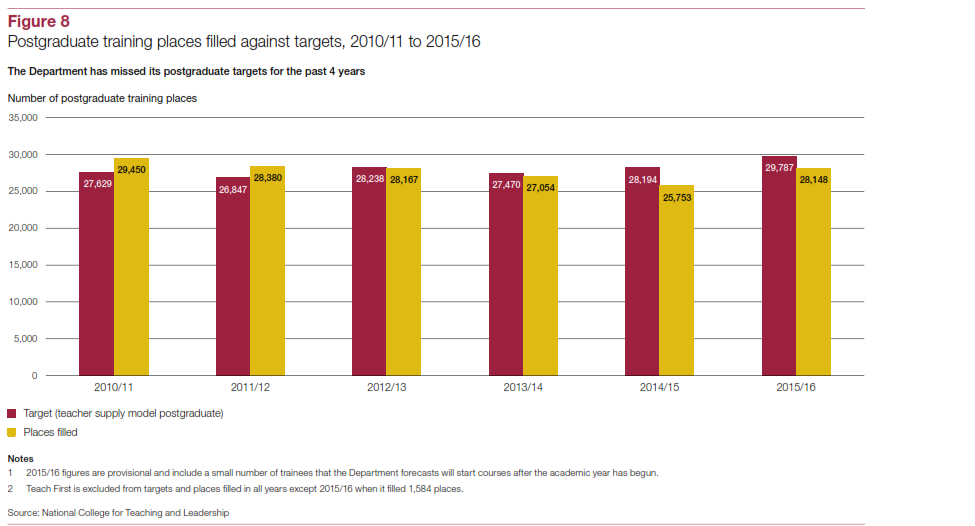
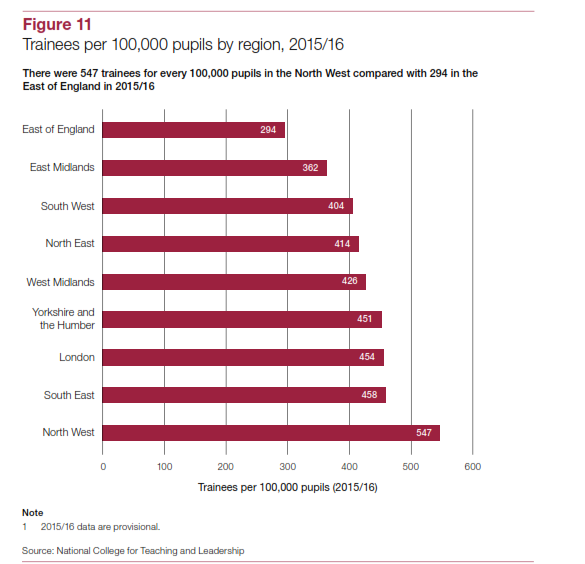
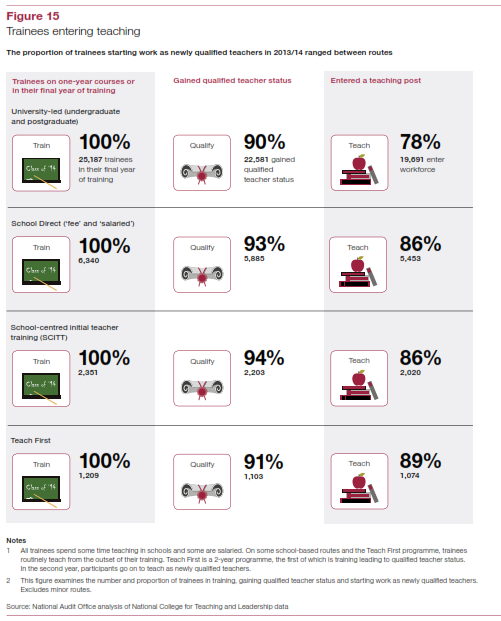
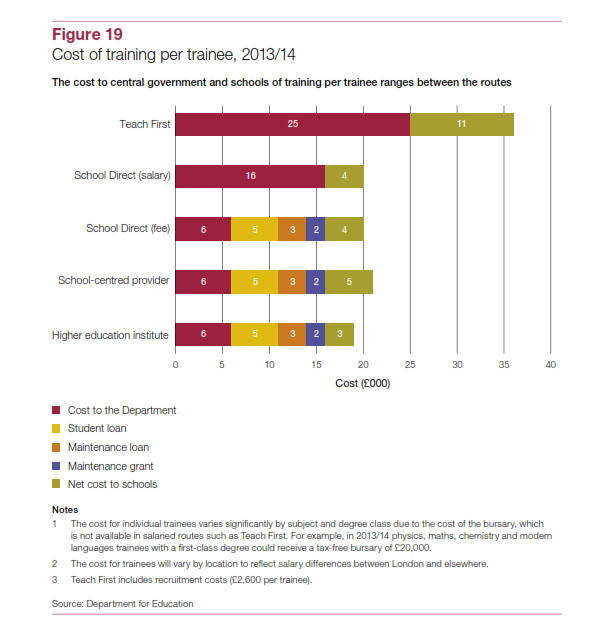
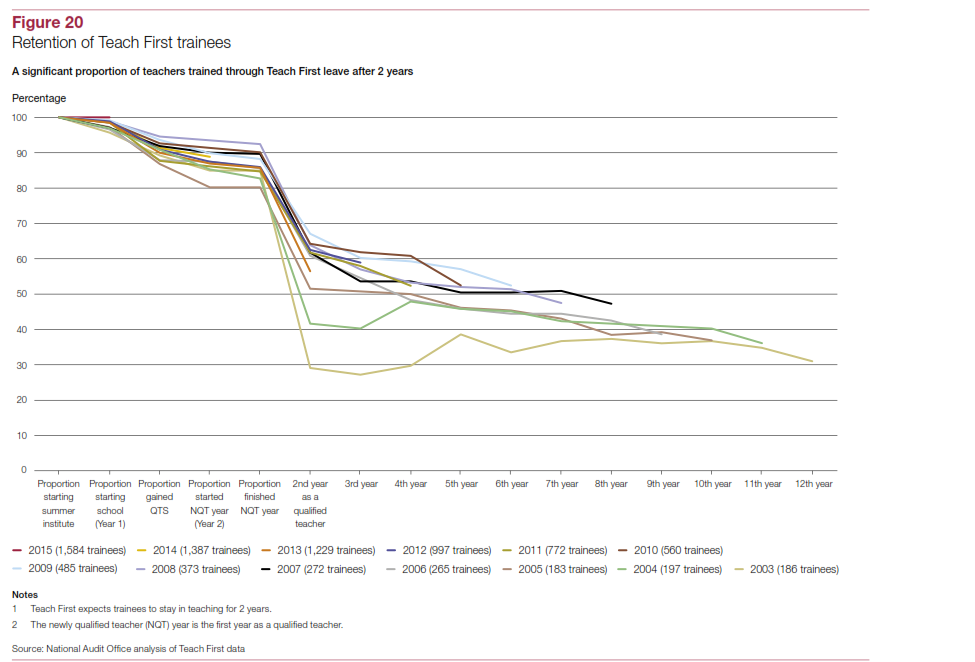





‘…there are no loans or grants for Teach First participants, and these are a cost to the government also.’ But Teach First participants are employed. Presumably this means they are paid a salary. That also is a cost to the government.
You are correct; participants are paid at the rate of an unqualified teacher during their first year, which then rises to the salary of an NQT in their second (once the PGCE is completed). I think it is worth mentioning that Teach First place their participants in schools which are struggling to recruit full time teachers, so would otherwise be paying for supply teachers (also a cost to the government). It would be interesting to see a price comparison between the Teach First participants and the supply counterparts.
An analysis of entrants into teaching a full year after qualifying would show many more HEI trained NQTs progressing into school, as many take a year out after qualifying, especially those coming through the undergraduate route.
Are tax payers getting value for money from Teach First? I think serious questions have to be asked.
£36k in government and school costs plus 2 years of pay only for the majority to leave after 2 years is such a waste of money.
Once again, Nick Gibb talking through his fundament on national TV this lunchtime. The DfE and ministers are like the officials at the notorious Maradona “Hand of God” match v England in June 1986 – the entire planet saw it apart from 3 people – the referee and the two linesmen. Gibb is like that referee – in total denial about the parlous situation that teacher recruitment finds itself in. He may be right in saying that they have appointed more teachers since coming to power, but it’s nowhere near enough, and this NAO report highlights the ineptitude of the DfE in addressing this problem in damning fashion.In all of the “thousands of classes” he has seen in the 400 schools he has visited, he doesn’t seem to have picked up on this problem which is exercising head teachers across the country. Taking together the coming bulge in pupil numbers, the vast exodus of experienced teachers and the embarrassing failure of Teach First to retain the staff it has trained, a perfect storm is about to engulf our schools, while Nick Gibb sticks his fingers in his ears and sings “La, la, la, la,” very loudly.